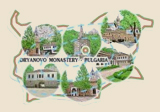Monasteries in the Balkan mountain range
The Balkan Mountain Range is known as the "spine" of Bulgaria. The great influence of the mountain in Bulgarian history has a great impact on the large number of monasteries in Balkan mountain range.
The Troyan and Glozhene monasteries are lying in the Balkan mountain range, as well as Klisura monastery, the Cherepish monastery and the The Osenovlashki Monastery, popular also as Sedemte Prestola (i.e. the Seven Altars). Those monasteries, which have contributed greatly to the cultural heritage at the beginning of the Second Bulgarian Empire around Veliko Tarnovo, are also secretly hidden at the foot of the Balkan Mountain Range - Sokolski Monastery “Assumption”, Patriarch monastery “Holy Trinity”, Transfiguration monastery , Plakovski Monastery of “St.Iliyan the Prophet” and many others which worth visiting.

Troyan Monastery “Holy Mother's Assumption”
Stauropegial Troyan monastery is the third biggest monastery in Bulgaria and the third in significance as well. It was built in 1600, but its present appearance dated back to the period 1835-1855 when the main church was erected. At present, the Troyan cloister is a complex of a main church and residential buildings, as well as two chapels-“ St Nikolay the Miracle-Worker” and “St. John the Baptist”.
monastery details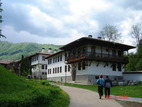
Klisura Monastery “St. St. Cyril and Methodius”
The Klisura Monastery is hidden in the picturesque valley of Vreshtitsa river, at the foot of Todorini Kukli peak in the the western part of the Balkan mountain. Klisura Monastery was founded in 1240 as at that time it was named Vreshetski. The Klisura Monastery offers accommodation at reasonable prices.
monastery details
Cherepish Monastery
Cherepish Monastery was established during the reign of tsar Ivan Shishman. It was mentioned in a document kept in the Sofia church, historical and archeological museum that the monastery was destroyed during the period of Ottoman invasion. The Cherepish Monastery was restored in the beginning of the 17th century by the renowned Bulgarian ecclesiastic, builder and painter Pimen Zograf of Sofia.
monastery details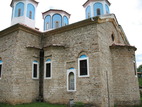
Etropole Monastery "St. Trinity"
The Etropole Monastery was established in the Middle Ages (1158). It is famous for its limestone base due to the limestone with which the monastery’s church was built. The legend says that the holy cloister’s existence may have been closely related to the name of the hermit Ivan Rilski, who had settled in one of the caves in the ‘Varovitets’ region before choosing solitude life in Rila. Nevertheless, the local people of Etropole declared the place holy and laid the foundations of the present-day monastery. Etropole “St.Trinity” monastery was one of the biggest literacy centres at Bulgarian lands in XVI and XVII century as the popular Etropole calligraphic and art school was established there.
monastery details
Glozhene Monastery „St. George the Victorious”
Glozhene Monastery “St. George the Victorious” was established in the middle of 13th century by the Ukrainian prince Glozh who settled in the area of the present village Glozhene with the permission of the Bulgarian king Ivan Assen II. He built there a monastery dedicated to the icon “St.George the Victorious”, which he carried with him all the way from the land of Ukraine.
monastery details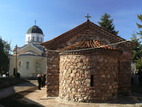
Kremikovtsi Monastery "St. George the Victorious"
It is believed that the Kremikovtsi Monastery was built during the reign of the king Ivan Alexander , but there is certain evidence for its existence from the 15th century. The oldest building there is the church “St.Georgi” dated back to the end of the 15th century and renovated two times. During the Ottoman Slavery the Kremikovtsi Monastery was an important literary and cultural centre for Sofia’s residents and many liturgical books have been transcribed there. Kremikovtsi cloister is a nunnery at the present
monastery details
Osenovlashki Monastery „Virgin Mary”
The legend says that the establishment of the Osenovlashki Monastery (the Seven Altars) is related to the name of the famous Bulgarian boyar Petar Deliyan and the rebellion against the Byzantine rule in 1040. The earliest historical evidence for the existence of the Osenovlashki Monastery was found in a Gospel dated back to 1511, and from another official document from 1554
monastery details
Patriarch Monastery “Holy Trinity”
The Patriarch Monastery “Holy Trinity” lies in an extraordinarily beautiful area at the foot of the picturesque Arbanassi plateau.According to some explorers, the Patriarch Monastery was established in 1070. Other records suggest that the holy cloister arose as far back as the reign of Ivan Alexander and its founders were Teodosii of Turnovo and Patriarch Evtimii. The Patriarch Monastery was plundered and demolished during the falling of Turnovo under Ottoman oppression. The Patriarch Monastery was restored in 1847 with the financial help of the local people, but on a different place, 1km away from the old monastery.
monastery details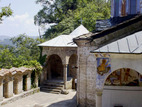
Sokolski Monastery “Holy Mother's Assumption”
Sokolski Monastery “Holy Mother’s Assumption” was founded in 1833 by archimandrite Yossif Sokolski. In the middle of the monastery yard is situated a beautiful white stone fountain with eight spouts . It was built in 1865 by the famous master Kolyo Ficheto. Sokolski Monastery, including its frescoes, has been recently restored with EU funds.
monastery details

 Popular monastery
Popular monastery  Monastery
Monastery  Inactive monastery
Inactive monastery 